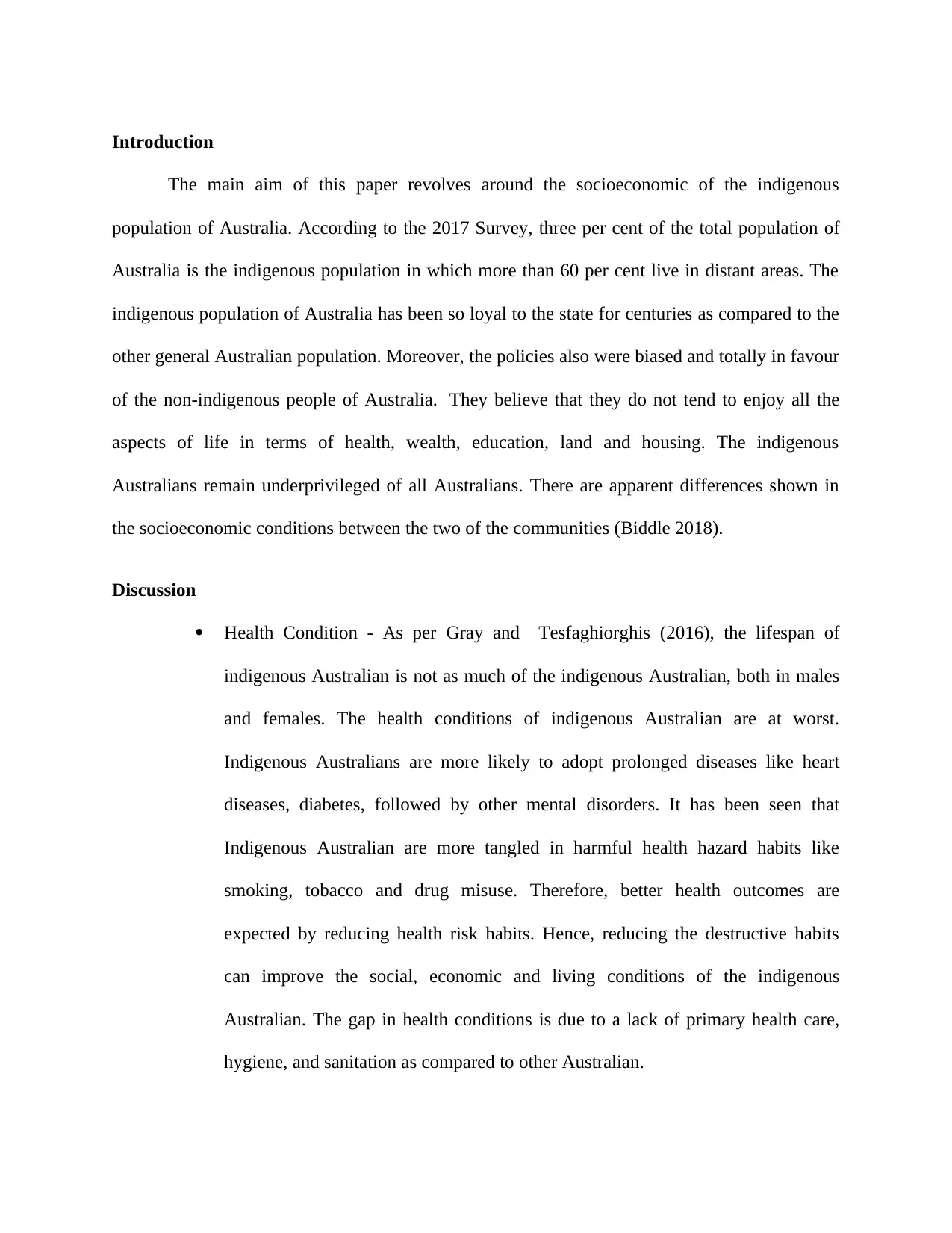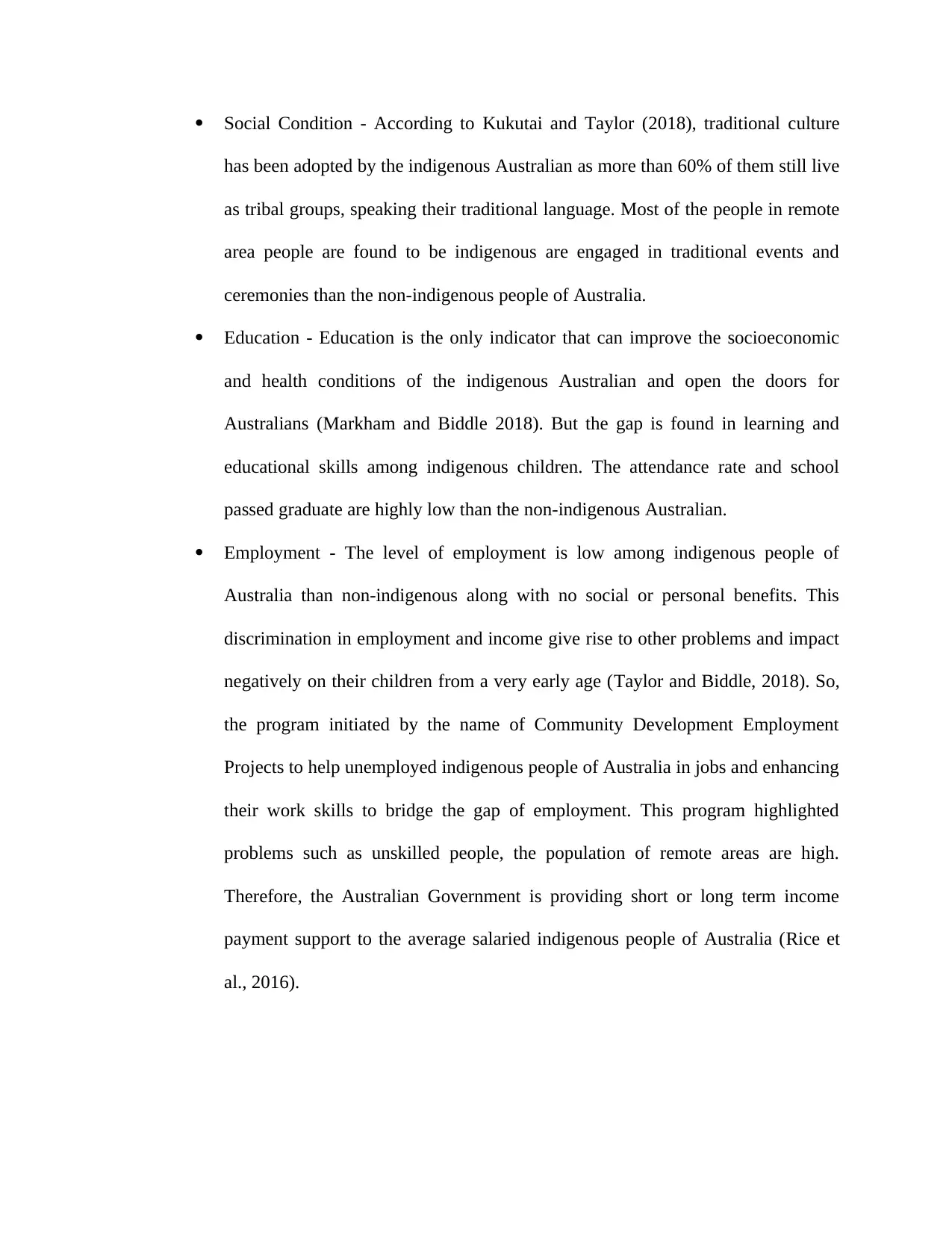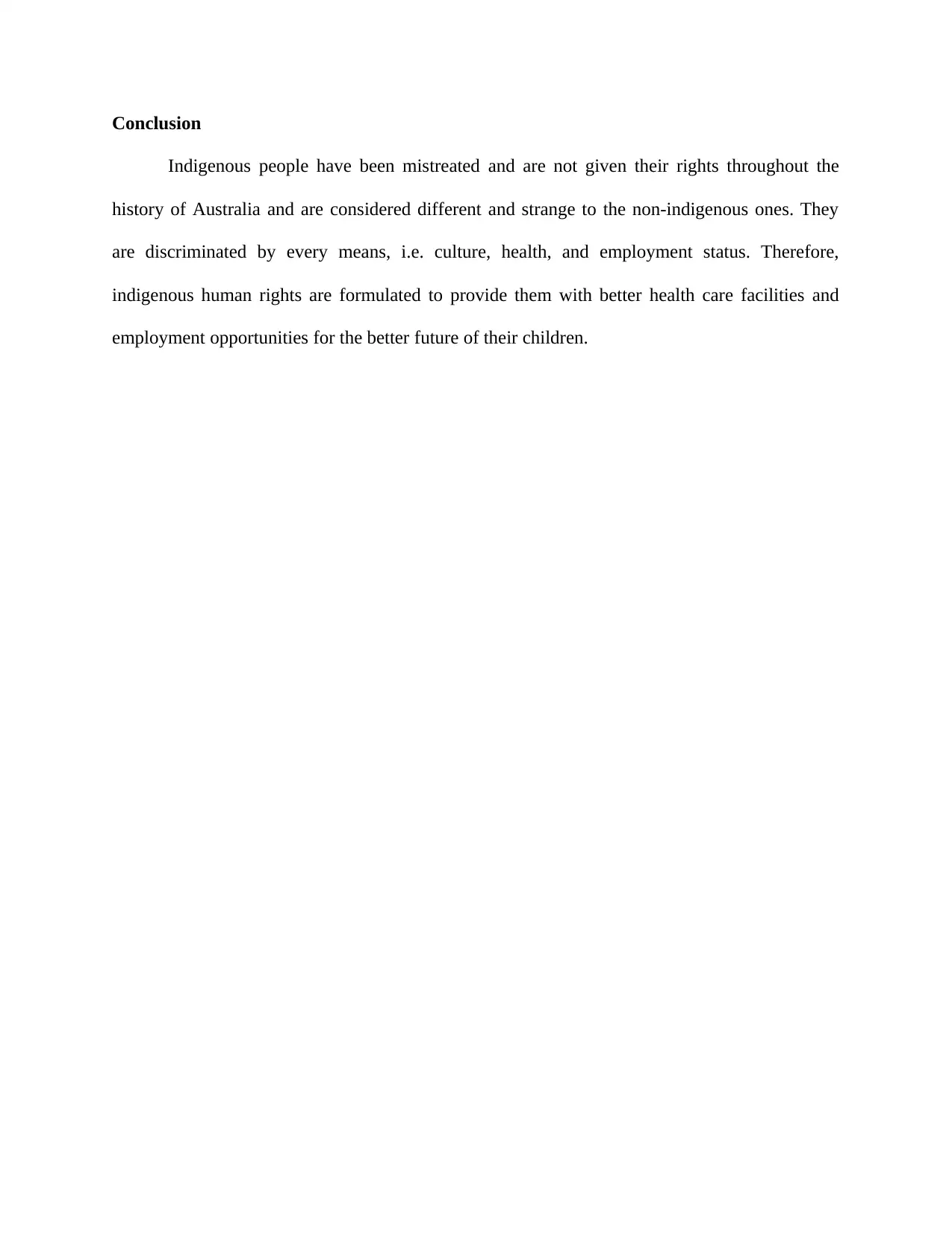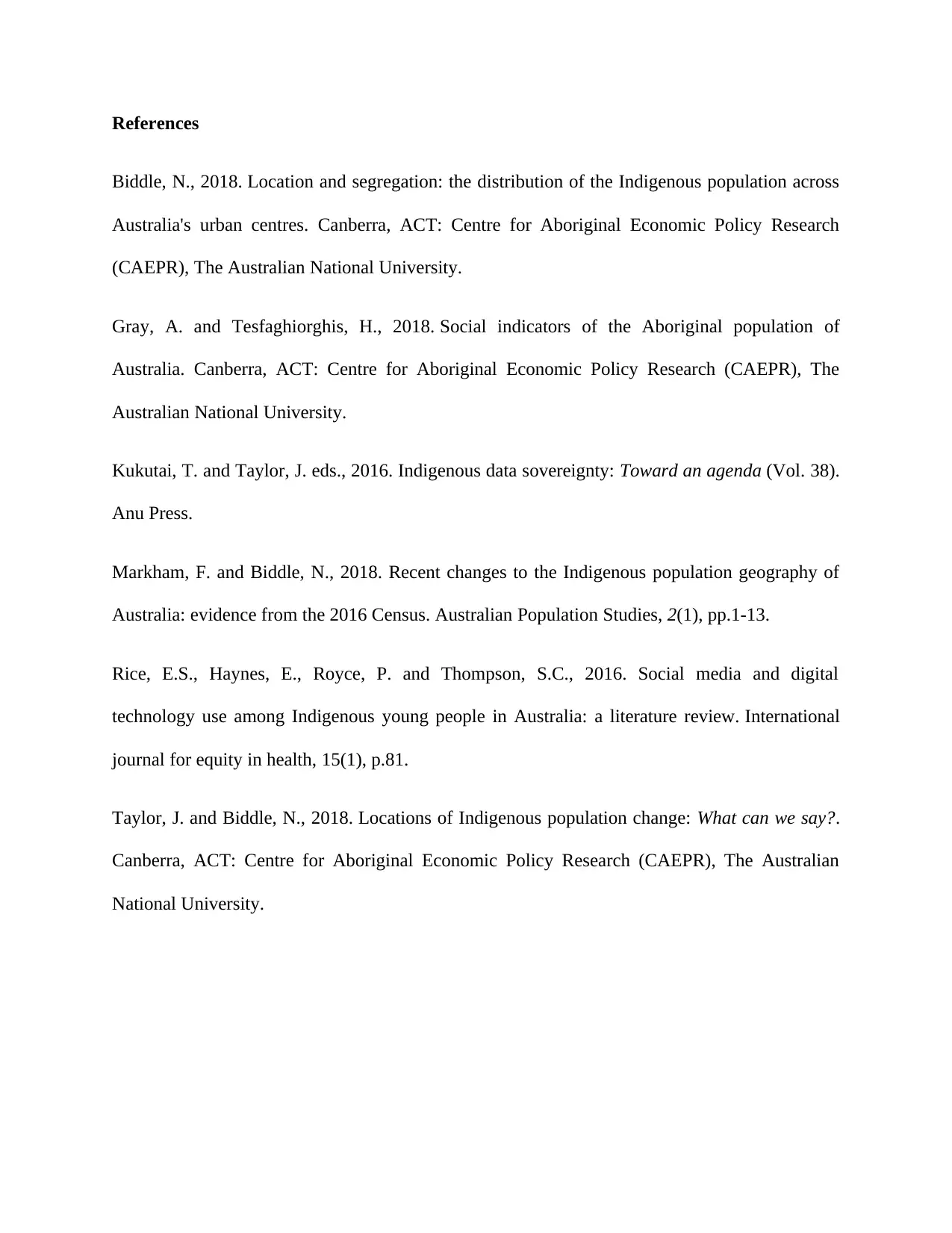Analyzing Socioeconomic Disparities: Indigenous Australians Study
VerifiedAdded on 2022/08/16
|4
|858
|13
Essay
AI Summary
This paper provides an overview of the socioeconomic conditions of the Indigenous population of Australia. It highlights disparities in health, education, and employment, and how these factors contribute to the underprivileged status of Indigenous Australians. The essay references the 2017 survey data and explores the health conditions, including the prevalence of diseases and harmful habits. It also discusses social conditions, emphasizing the importance of traditional culture, and examines the education and employment gaps between Indigenous and non-Indigenous Australians. The paper concludes by emphasizing the historical mistreatment and discrimination faced by Indigenous people and advocates for human rights to improve their socioeconomic outcomes. The essay is supported by various research papers and studies to substantiate its findings.

Introduction
The main aim of this paper revolves around the socioeconomic of the indigenous
population of Australia. According to the 2017 Survey, three per cent of the total population of
Australia is the indigenous population in which more than 60 per cent live in distant areas. The
indigenous population of Australia has been so loyal to the state for centuries as compared to the
other general Australian population. Moreover, the policies also were biased and totally in favour
of the non-indigenous people of Australia. They believe that they do not tend to enjoy all the
aspects of life in terms of health, wealth, education, land and housing. The indigenous
Australians remain underprivileged of all Australians. There are apparent differences shown in
the socioeconomic conditions between the two of the communities (Biddle 2018).
Discussion
Health Condition - As per Gray and Tesfaghiorghis (2016), the lifespan of
indigenous Australian is not as much of the indigenous Australian, both in males
and females. The health conditions of indigenous Australian are at worst.
Indigenous Australians are more likely to adopt prolonged diseases like heart
diseases, diabetes, followed by other mental disorders. It has been seen that
Indigenous Australian are more tangled in harmful health hazard habits like
smoking, tobacco and drug misuse. Therefore, better health outcomes are
expected by reducing health risk habits. Hence, reducing the destructive habits
can improve the social, economic and living conditions of the indigenous
Australian. The gap in health conditions is due to a lack of primary health care,
hygiene, and sanitation as compared to other Australian.
The main aim of this paper revolves around the socioeconomic of the indigenous
population of Australia. According to the 2017 Survey, three per cent of the total population of
Australia is the indigenous population in which more than 60 per cent live in distant areas. The
indigenous population of Australia has been so loyal to the state for centuries as compared to the
other general Australian population. Moreover, the policies also were biased and totally in favour
of the non-indigenous people of Australia. They believe that they do not tend to enjoy all the
aspects of life in terms of health, wealth, education, land and housing. The indigenous
Australians remain underprivileged of all Australians. There are apparent differences shown in
the socioeconomic conditions between the two of the communities (Biddle 2018).
Discussion
Health Condition - As per Gray and Tesfaghiorghis (2016), the lifespan of
indigenous Australian is not as much of the indigenous Australian, both in males
and females. The health conditions of indigenous Australian are at worst.
Indigenous Australians are more likely to adopt prolonged diseases like heart
diseases, diabetes, followed by other mental disorders. It has been seen that
Indigenous Australian are more tangled in harmful health hazard habits like
smoking, tobacco and drug misuse. Therefore, better health outcomes are
expected by reducing health risk habits. Hence, reducing the destructive habits
can improve the social, economic and living conditions of the indigenous
Australian. The gap in health conditions is due to a lack of primary health care,
hygiene, and sanitation as compared to other Australian.
Paraphrase This Document
Need a fresh take? Get an instant paraphrase of this document with our AI Paraphraser

Social Condition - According to Kukutai and Taylor (2018), traditional culture
has been adopted by the indigenous Australian as more than 60% of them still live
as tribal groups, speaking their traditional language. Most of the people in remote
area people are found to be indigenous are engaged in traditional events and
ceremonies than the non-indigenous people of Australia.
Education - Education is the only indicator that can improve the socioeconomic
and health conditions of the indigenous Australian and open the doors for
Australians (Markham and Biddle 2018). But the gap is found in learning and
educational skills among indigenous children. The attendance rate and school
passed graduate are highly low than the non-indigenous Australian.
Employment - The level of employment is low among indigenous people of
Australia than non-indigenous along with no social or personal benefits. This
discrimination in employment and income give rise to other problems and impact
negatively on their children from a very early age (Taylor and Biddle, 2018). So,
the program initiated by the name of Community Development Employment
Projects to help unemployed indigenous people of Australia in jobs and enhancing
their work skills to bridge the gap of employment. This program highlighted
problems such as unskilled people, the population of remote areas are high.
Therefore, the Australian Government is providing short or long term income
payment support to the average salaried indigenous people of Australia (Rice et
al., 2016).
has been adopted by the indigenous Australian as more than 60% of them still live
as tribal groups, speaking their traditional language. Most of the people in remote
area people are found to be indigenous are engaged in traditional events and
ceremonies than the non-indigenous people of Australia.
Education - Education is the only indicator that can improve the socioeconomic
and health conditions of the indigenous Australian and open the doors for
Australians (Markham and Biddle 2018). But the gap is found in learning and
educational skills among indigenous children. The attendance rate and school
passed graduate are highly low than the non-indigenous Australian.
Employment - The level of employment is low among indigenous people of
Australia than non-indigenous along with no social or personal benefits. This
discrimination in employment and income give rise to other problems and impact
negatively on their children from a very early age (Taylor and Biddle, 2018). So,
the program initiated by the name of Community Development Employment
Projects to help unemployed indigenous people of Australia in jobs and enhancing
their work skills to bridge the gap of employment. This program highlighted
problems such as unskilled people, the population of remote areas are high.
Therefore, the Australian Government is providing short or long term income
payment support to the average salaried indigenous people of Australia (Rice et
al., 2016).

Conclusion
Indigenous people have been mistreated and are not given their rights throughout the
history of Australia and are considered different and strange to the non-indigenous ones. They
are discriminated by every means, i.e. culture, health, and employment status. Therefore,
indigenous human rights are formulated to provide them with better health care facilities and
employment opportunities for the better future of their children.
Indigenous people have been mistreated and are not given their rights throughout the
history of Australia and are considered different and strange to the non-indigenous ones. They
are discriminated by every means, i.e. culture, health, and employment status. Therefore,
indigenous human rights are formulated to provide them with better health care facilities and
employment opportunities for the better future of their children.
⊘ This is a preview!⊘
Do you want full access?
Subscribe today to unlock all pages.

Trusted by 1+ million students worldwide

References
Biddle, N., 2018. Location and segregation: the distribution of the Indigenous population across
Australia's urban centres. Canberra, ACT: Centre for Aboriginal Economic Policy Research
(CAEPR), The Australian National University.
Gray, A. and Tesfaghiorghis, H., 2018. Social indicators of the Aboriginal population of
Australia. Canberra, ACT: Centre for Aboriginal Economic Policy Research (CAEPR), The
Australian National University.
Kukutai, T. and Taylor, J. eds., 2016. Indigenous data sovereignty: Toward an agenda (Vol. 38).
Anu Press.
Markham, F. and Biddle, N., 2018. Recent changes to the Indigenous population geography of
Australia: evidence from the 2016 Census. Australian Population Studies, 2(1), pp.1-13.
Rice, E.S., Haynes, E., Royce, P. and Thompson, S.C., 2016. Social media and digital
technology use among Indigenous young people in Australia: a literature review. International
journal for equity in health, 15(1), p.81.
Taylor, J. and Biddle, N., 2018. Locations of Indigenous population change: What can we say?.
Canberra, ACT: Centre for Aboriginal Economic Policy Research (CAEPR), The Australian
National University.
Biddle, N., 2018. Location and segregation: the distribution of the Indigenous population across
Australia's urban centres. Canberra, ACT: Centre for Aboriginal Economic Policy Research
(CAEPR), The Australian National University.
Gray, A. and Tesfaghiorghis, H., 2018. Social indicators of the Aboriginal population of
Australia. Canberra, ACT: Centre for Aboriginal Economic Policy Research (CAEPR), The
Australian National University.
Kukutai, T. and Taylor, J. eds., 2016. Indigenous data sovereignty: Toward an agenda (Vol. 38).
Anu Press.
Markham, F. and Biddle, N., 2018. Recent changes to the Indigenous population geography of
Australia: evidence from the 2016 Census. Australian Population Studies, 2(1), pp.1-13.
Rice, E.S., Haynes, E., Royce, P. and Thompson, S.C., 2016. Social media and digital
technology use among Indigenous young people in Australia: a literature review. International
journal for equity in health, 15(1), p.81.
Taylor, J. and Biddle, N., 2018. Locations of Indigenous population change: What can we say?.
Canberra, ACT: Centre for Aboriginal Economic Policy Research (CAEPR), The Australian
National University.
1 out of 4
Related Documents
Your All-in-One AI-Powered Toolkit for Academic Success.
+13062052269
info@desklib.com
Available 24*7 on WhatsApp / Email
![[object Object]](/_next/static/media/star-bottom.7253800d.svg)
Unlock your academic potential
Copyright © 2020–2025 A2Z Services. All Rights Reserved. Developed and managed by ZUCOL.




